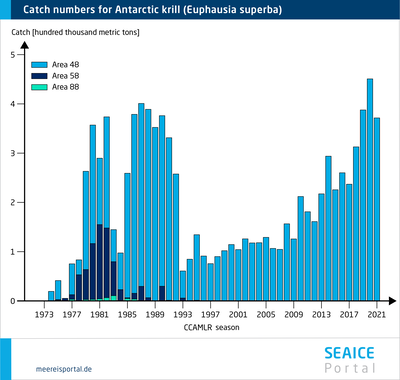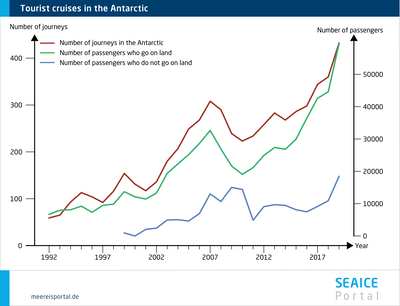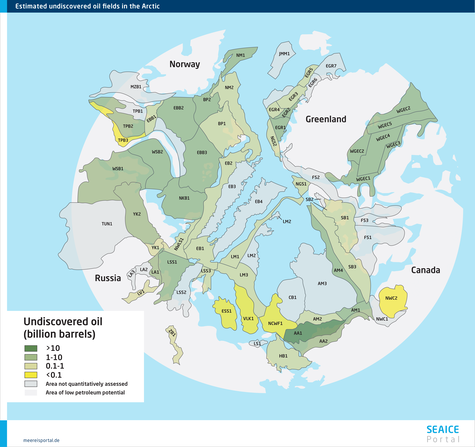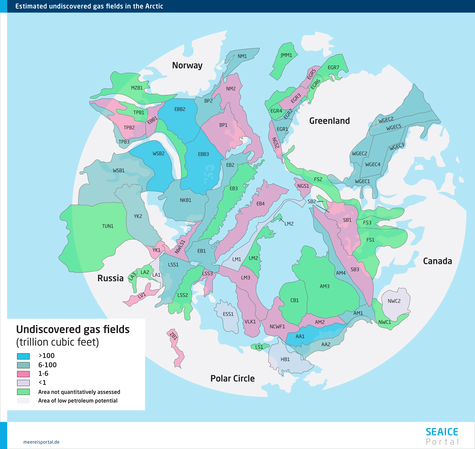Use by Humans
Human beings have always used the resources of the polar regions. In the distant past, this was limited to indigenous peoples, who lived in the Arctic and lived off its resources. Seals and fish were their main food sources. Skins were made into clothing. Later, in the 19th and early 20th centuries, the commercial use of resources began – walrus hunting, whaling and large-scale fishing. Overfishing of the fish and krill stocks, and overuse of the mammalian stocks, were the result. Legal regulations and catch limits were subsequently introduced in order to limit hunting and fishing. Nevertheless, international fishing on the high seas is difficult to monitor. In the following, examples concerning individual species are briefly presented. In this regard, the environmental policies, hunting bans and catch limits affect not only the industrial harvesting of certain species, but also the hunting and fishing practices of indigenous Arctic peoples, although their non-commercial use of the Arctic fauna has never had a significant impact on local biodiversity. In addition, this section will address further types of use, e.g. the growing tourism in the polar regions. Since the sea ice is increasingly retreating in the summer months, the Arctic is also becoming more and more interesting for international shipping and natural resource exploration.
Krill is a keystone species in the Antarctic and depends directly on the sea ice. The krill is a freeswimming bioluminescent crustacean and belongs to the zooplankton. Roughly six centimetres long, krill occur in large swarms. There are an estimated 122 to 215 million metric tons of krill – the main prey species for various fishes, certain species of whale, penguins and other seabirds – in the Antarctic (Maribus WOR6, 2019). Commercial krill fishing began in the 1970s, chiefly due to the interests of two major industrial consumers: the fishing industry and the food industry. In the fishing industry, krill meal is used as a fish food in aquaculture worldwide. For the food industry, krill are especially interesting due to their high omega-3 fatty acid content. On board ships, krill are processed into krill oil, which is sold in capsule form. In many countries, these capsules are a favoured nutritional supplement. Until the early 1990s, the most important krill-fishing nation was the USSR; after its collapse, Japan became the largest krill producer. Since the 2010s, however, Japan and today’s Russia have largely abandoned krill fishing; however, Norway has been particularly active since the 2010s; South Korea is a distant second. Whereas the annual amount caught was still more than 500,000 metric tons in the early 1980s, with the end of the Soviet Union it dwindled to ca. 50,000 metric tons. There has since been a major resurgence, with the level reaching 300,000 metric tons in 2018. Antarctic krill are almost exclusively fished in the Atlantic sector of the Southern Ocean. Today, ca. 90 percent of the krill caught are made into fish meal, with the remaining 10 percent processed into protein pastes and krill oil (Siegel, 2014). How krill are used will likely change once again in the foreseeable future, given the growing demand in the chemical and pharmaceutical industries.
In light of the tremendous quantities of krill caught in the 1980s, experts feared that the species, so crucial to the Antarctic food web, could be overfished. In response, in 1991 the first maximum catch limit was introduced for the Atlantic sector of the Southern Ocean. The Convention on the Conservation of Antarctic Marine Living Resources (CCAMLR) monitors krill populations and can flexibly impose new catch limits on the basis of its observations, so as to ensure the stocks are used sustainably. But the krill stocks aren’t the only thing that needs observing; it’s also important to monitor those animals that depend on the krill – e.g. penguins and seals. They, too, would be impacted if krill were overfished.
The most important fishing grounds in the Atlantic Arctic are the Barents Sea, European North Sea, and the waters off Greenland and Iceland. Here, the main species fished are the Atlantic cod (Gadus morhua), haddock (Melanogrammus aeglefinus), Atlantic herring (Clupea harengus) and Arctic species like capelin (Mallotus villosus), Greenland halibut (Reinhardtius hippoglossoides), northern prawn (Pandalus borealis) and polar cod (Boreogadus saida). As a result of climate change, other species have migrated to the Atlantic Arctic and are now commercially fished. For example, since the early 2000s the composition of fish species in the Barents Sea has changed. Whereas in the past, predominantly Arctic species like the fathead sculpin (Triclops nybelini), Greenland halibut (Reinhardtius hippoglossoides) and seasnails (Liparis spp.) were fished, today it is mostly North Atlantic fish species that prefer warmer waters, like the Atlantic cod, haddock and plaice (Hippoglossoides platessoides). And off the coasts of Greenland, Newfoundland and Labrador, now fish from southern regions of the Atlantic are increasingly fished – like the bluefin tuna (Thunnus thynnus) (Maribus WOR6, 2019).
The Northwest Pacific is another highly productive region. Here, the average volume is more than 20 million metric tons of fish and seafood per year – the highest worldwide. In the Northeast Pacific, in contrast, the number is only ca. 3 million. In the North Pacific, especially the Alaska pollock (Gadus chalcogrammus), Pacific cod (Gadus macrocephalus), Pacific halibut (Hippoglossus stenolepis), crabs and Pacific salmon species like the sockeye salmon (Oncorhynchus nerka) are fished. For comparison: in the Arctic regions of the Northwest and Northeast Atlantic, ca. 10 million metric tons of fish and seafood a year are caught, predominantly in the ice-free coastal waters (Maribus WOR6, 2019). Today, fishing in Arctic waters is governed by a host of national and international conventions and regulations – including national legislation, the joint fishing policy of the European Union, and especially the regional organisations for fishery management. The latter include the countries bordering on the respective waters, but also other countries that regularly fish in these regions. To avoid overfishing the stocks, today fishing seasons, licenses and limits are issued for all areas of the Arctic, on the basis of scientific recommendations.
As the example of krill shows, the waters of the Antarctic have also been fished for years. And just as with krill, the Convention on the Conservation of Antarctic Marine Living Resources (CCAMLR) also monitors fishing near the South Pole. The goal of the CCAMLR convention is to preserve all marine species and ecosystems in the Southern Ocean, while by no means banning fishing. In order to nevertheless achieve said goal, nature conservation is given priority over fishing interests. The CCAMLR Convention, too, relies on scientific findings regarding current stock sizes when defining catch limits.
For fishing in the Antarctic, krill are far and away the most important species. Aside from them, few other species are fished. These especially include the mackerel icefish (Champsocephalus gunnari), Patagonian toothfish (Dissostichus eleginoides) and Antarctic toothfish (Dissostichus mawsoni). Russia has recently begun catching the Antarctic stone crab and king crab (Neolithodes yaldwyni and Paralomis birsteini) as well. But in comparison to the volumes caught in the Arctic, those in the Antarctic are relatively small. For example, ca. 10,000 metric tons of Patagonian tooth-fish and ca. 4,000 metric tons of Antarctic toothfish are caught per year (Maribus WOR6, 2019).
For millennia, seals in the Arctic were only hunted by indigenous peoples, which, compared to the commercial hunting that would follow, had very little influence on seal stocks. Having begun in the 16th century, commercial hunting has since become far more professional. The seal species with the greatest distribution, the ringed seal, is still hunted today, with the highest limit. In the 1990s, ca. 70,000 ringed seals per year were killed in Greenland. In Canada, between 50,000 and 65,000 are killed every year. This limit has remained unchanged since the 1990s and has very little effect on the total population (Blanchet et al., 2014). The bearded seal and harp seal are also hunted, with ca. 5,000 to 10,000 bearded seals being killed per year. This does not endanger the population (Blanchet et al., 2014). In the past, harp seals were intensively hunted from the land in coastal regions, which decimated their population. In the 1970s, new legislation introduced a shorter hunting season, harvesting limits, and protection for sexually mature females. In the interim, the harp seal population has recovered in some regions. In 2007, the commercial hunting of hooded seals in the Greenland Sea was completely prohibited.
In contrast, the ribbon seal, which lives in the Arctic regions of the Pacific and particularly in the Bering Sea, is difficult to hunt from land, as it primarily lives in the water. As such, its population has experienced less pressure and is most likely now approaching the size it had before commercial hunting, though no current estimates of its subpopulations are available. The spotted seal, which is also found in the North Pacific, was especially hunted by ship. In the meantime, this type of hunting has been discontinued.
For centuries, the walrus – which lives in both the northern and southern polar regions – was one of the most heavily hunted seal species. The intensive hunting of walruses began in the Svalbard archipelago, after the Dutch seaman and explorer Willem Barents first surveyed the western coast of the main island and discovered large walrus stocks in 1596 (Maribus WOR6, 2019). Over time, human beings drove the walrus to extinction there. It is only since the ban on walrus hunting in the 1950s that walruses have returned to Svalbard, most likely from Russia’s Franz Joseph Land archipelago (Blanchet et a. 2014).
In the late 18th century, there were the first reports of large seal populations in the South Atlantic. In response, seal hunting began on South Georgia, an island in the South Atlantic, half a century before the Antarctic was discovered. At first, especially the Antarctic fur seal and sea elephant were hunted. In the decades that followed, hunting was extended to other islands in the South Atlantic, to the southern Shetland Islands. Fur seals were chiefly hunted on the Kerguelen and McDonald Islands. After just 20 years, the largest populations were all but gone. Ultimately only a few hundred seals remained; after the end of commercial seal hunting around 1900, they formed the basis for the stocks’ recovery. One important reason for the end of seal hunting was the advent of petroleum as lamp oil, which replaced the seal oil commonly used up to that point.
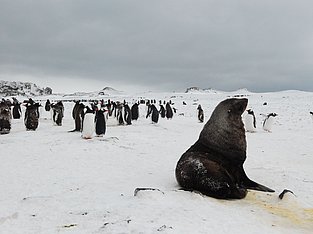
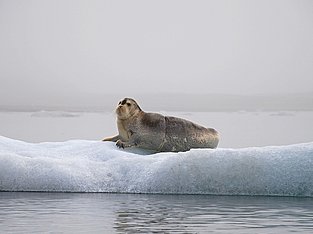
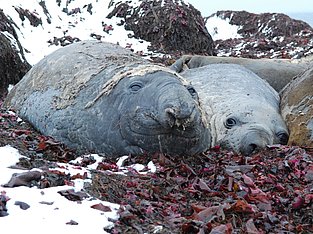
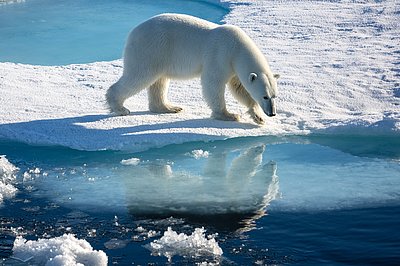
Polar bears, too, have been hunted for centuries. As was the case with the walrus, in Svalbard the intensive hunting began after the archipelago was first surveyed in the 16th century. After that, the polar bear population was decimated but not wholly destroyed. Today, polar bears enjoy complete protection in Svalbard and in the Russian Arctic. Generally speaking, policies on the local polar bear population vary from country to country. For the indigenous Arctic peoples of Alaska, Canada and Greenland, hunting polar bears is an important part of their culture and economy, which is why the policies are laxer. In Greenland there has been a maximum harvesting limit in place since 2006, which was set at 140 bears per year in 2013, while in Canada a quota system is used to allocate a limited number of permitted kills (Blanchet, 2014). In the USA, legislation protecting polar bears includes exceptions for Alaska Natives who live on the coast, since polar bears remain part of their livelihood today, including the production and sale of handicrafts. However, both the voluntary Inuvialuit-Inupiat Polar Bear Management Agreement and a bilateral agreement between the USA and Russia prohibit the hunting of female polar bears with cubs.
For centuries, whales were intensively hunted, especially in Arctic waters, which led to the near-extinction of e.g. the Greenland whale. In the Antarctic, intensive hunting began with the advent of the harpoon cannon, which made it possible to also hunt fast-moving rorquals like the blue whale, sei whale and common minke whale, not to mention the humpback whale. In addition, the construction of the first land-based station for processing the killed whales, on South Georgia in 1904, further intensified whaling in the Antarctic (Maribus WOR6, 2019).
It was only after the stocks had been seriously depleted that measures to protect the whales were gradually considered – starting with protection for the virtually extinct Greenland whale in the Arctic via the Geneva Whaling Convention in 1931. Only the indigenous peoples were still allowed to hunt the Greenland whale. In return, they were required to conduct surveys of the stocks at regular intervals. Moreover, commercial hunting was prohibited for them, too. Aside from the status of the Greenland whale, however, very little changed; other whales continued to be hunted. In fact, whaling in the Antarctic peaked in the 1930/1931 season: in just one year, roughly 15,000 blue whales, 28,000 fin whales and 2,000 humpback whales were killed (Maribus WOR6, 2019). For many years, especially Norway was extremely active in whaling, and kept hunting in Antarctic waters even after the stocks had been drastically depleted.
In 1945, the whaling nations gathered for another international conference, and on 2 December 1946 the International Convention for the Regulation of Whaling (ICRW) was finally ratified in Washington. The ICRW entered into effect in 1948 and laid the groundwork for the creation of the International Whaling Commission (IWC). Although many nations signed the document establishing the Commission, several of them – e.g. Japan – never enacted it so that they could continue whaling. In the 1947/48 season there were 15 factory ships in the Antarctic; from 1950 to 1960 there were an average of 20 ships/year (Deimer-Schütte, 2014).
Essentially, whenever a given whale population collapsed, the hunting would simply switch to other species. For example, after the number of blue whales in the Antarctic had dropped dramatically, the fin whale and sei whale – and later, the much smaller common minke whale – became the new targets. The IWC, which had at the time only introduced a single formula for comparing and regulating the hunting limits, could do nothing to stop this troubling trend, which was spurred on by commercial competition (Deimer-Schütte, 2014).
Commercial whaling wasn’t banned until a moratorium that entered into effect in 1986, after public pressure had become too great in the early 1980s. The indigenous peoples of Siberia and Alaska were exempted, as whaling represented not only a livelihood for them, but also an important element of their culture. In addition, Norway, Japan, South Korea and Iceland subsequently granted exceptions for whaling for scientific purposes. These countries continue to hunt whales today. However, there is now far more money to be made from ship tours to regions with whales than from whaling (Deimer-Schütte, 2014).
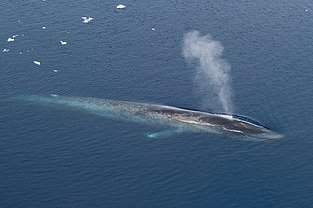
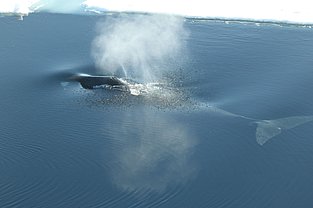
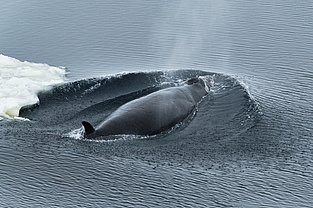
A very different form of commercial exploitation of the Arctic’s and Antarctic’s resources is the growing tourism in the polar regions. Because they’re comparatively easy to reach, especially Alaska, Iceland and northern Scandinavia have been popular destinations for years. Due in part to the growing interest in cruises to the polar regions, since the 2000s Greenland and Svalbard have also gained in popularity, attracting ca. 24,000 and ca. 40,000 tourists/year, respectively. But especially the Antarctic, as the last true frontier on the planet, has become more appealing to tourists in recent years. Today, a number of cruise ships are underway near the South Pole between November and March. Whereas there were only ten tour operators who brought ca. 6,700 tourists to the Antarctic in the 1992/1993 season, by the 2019/2020 season the numbers had grown to nearly 50 tour operators and ca. 78,000 tourists (Maribus WOR6, 2019). Though inconceivable only a few decades ago, today the tourism sector has now found its way to the most isolated polar regions. In addition to cruises, there are helicopter flights, athletic activities in the snow, and hiking on the ice. The most common destination is the Antarctic Peninsula. When it comes to the Arctic, there are no exact figures on the number of tourists.
Yet this growth in tourism is definitely creating new difficulties. For example, new infrastructure is now being created to offer travellers to the North Pole more comfort (Mayer, 2014). On the one hand this means new jobs; on the other, it means new problems. These include more litter; land, air and water pollution resulting from increased air travel and shipping; a greater likelihood of accidents, especially for cruise liners; and disruptions for the region’s fauna. That being said, travelling to comparatively untouched regions can promote a greater awareness for nature conservation and a better understanding of the respective region. Ideally, such insights could even have political ramifications. This trend could offer an economic upswing for indigenous settlements. Further, it could mean that more value is attached to their traditions. Lastly, the more frequent ship arrivals and collaborations can offer new supply and networking opportunities for native inhabitants (Mayer, 2014).
In the future, tourism will expand, a trend that will be accompanied by larger cruise ships and the construction of new infrastructure and logistical facilities on land. There are currently efforts to establish a certification system, so as to ensure that certain technical and safety requirements are met. In addition, there are to be structures put in place that inform organisers about the effects of tourism and possibilities for minimising them. Local guidelines are already helping by limiting the touristic use of this fragile environment. Nevertheless, a sustainable tourism concept must be established in the foreseeable future so as to regulate the number of visitors (Mayer, 2014).
As the ice-free areas of the Arctic Ocean expand, new avenues are opening for tapping the energy reservoirs of the northern polar sea. There are believed to be substantial oil and natural gas deposits on Russia’s Arctic coast and the northeast tip of Greenland. Further large reservoirs can be found on the coasts of Alaska, western Canada and northern Norway. There are already active natural gas and petroleum production programmes on the coasts of Alaska, northern Norway and Scotland. As a result, today roughly ten percent of global petroleum production and 25 percent of natural gas production activities take place in the Arctic (Maribus WOR6, 2019). Nevertheless, in terms of oil and gas production, major expanses of the Arctic remain undeveloped because many deposits have yet to be discovered. In 2008, the US Geological Survey (USGS) study CARA (Circum-Arctic Resource Appraisal) sought to determine how large the still-undiscovered gas and oil deposits were. According to the CARA estimates, ca. 20 percent of the world’s undiscovered natural gas deposits and ca. 13 percent of its undiscovered petroleum deposits lie north of the Arctic Circle (Maribus WOR6, 2019). The USGS figures indicate that some Arctic states are home to especially large deposits: two thirds of these resources lie in the Eurasian part of the Arctic and the remaining third in the North American Arctic. The deposits in the Eurasian Arctic are ca. 90 percent natural gas; those in the North American Arctic are mostly petroleum (Maribus WOR6, 2019). Russia is the resource-richest Arctic state (home to roughly half of the undiscovered deposits), followed by the USA with Alaska (one fifth), Norway, Denmark / Greenland and Canada (Maribus WOR6, 2019). However, just because a given deposit has been discovered doesn’t necessarily mean it will be exploited: Arctic-wide, there are several deposits that were discovered as long as 50 years ago, but which, due to questions of profitability or environmental protection, have yet to be exploited. This is especially true for deposits in the North American Arctic, where oil and gas production is solely governed by market demand. Conversely, in Russia oil and gas production is also of strategic and political importance.
Using these resources can on the one hand open a number of new opportunities and holds considerable economic potential; on the other hand, it entails certain risks. Increased pollution from e.g. by blowout accidents (uncontrolled release of oil, gas and other materials from a borehole, which can pose serious health risks and a major environmental hazard)) on oil platforms can produce lasting and severe effects in the sensitive polar ecosystem. Due to the low temperatures, oil is broken down only very slowly. Further, pollutants survive longer in the Arctic ecosystem. This is a key difference to other oceans with higher temperatures, where pollutants, especially chemical compounds in the oil, can be released by the ocean through evaporation.
Oil is toxic for the majority of marine organisms. As a result, it can do considerable harm when, through an accident, it reaches the water column. Even more problematic: an oil spill when the water is covered with ice. The oil can penetrate the ice through the brine channels or be flushed out of it by waves. In addition, the broad-scale movement of the sea ice can spread oil and pollutants. Normally oil spills on the water’s surface can be dissolved using chemicals; occasionally, they are burnt off instead (Lange, 2014). In regions with sea-ice cover this would be impossible. The best technical solution is considered to be the use of microorganisms so as to reinforce and accelerate the natural breaking down of oil (induced bioremediation). This method, which has proven highly effective to date, is constantly being monitored and refined. However, at low temperatures it only works comparatively slowly.
Another risk: the release of carbon soot, an effect of gas and oil being burnt at production facilities. The soot is deposited on the ice, darkening its surface. This reduces the ice’s albedo, i.e., its ability to reflect sunlight. As a result, its surface absorbs more sunlight and warms more quickly, which accelerates melting. The consequences that premature melting can have for Arctic habitats and their food webs are only partly understood (Lange, 2014).
Blanchet M-A., M. Aquarone & U. Siebert (2014): Arktische Robben und Eisbären – Auswirkungen von Klimaerwärmung und Ressourcennutzung. In: Lozán, J.L., H.Grassl, D.Notz & D.Piepenburg: WARNSIGNAL KLIMA: Die Polarregionen. Wissenschaftliche Auswertungen, Hamburg, pp. 183- 191. ISBN: 978-39809668-63
Deimer-Schütte P. (2014): Warnsignale Walfang. In: Lozán, J.L., H.Grassl, D.Notz & D.Piepenburg: WARNSIGNAL KLIMA: Die Polarregionen. Wissenschaftliche Auswertungen, Hamburg, pp. 192-199. ISBN: 978-39809668-63
Lange M. A. (2014): Die Nutzung von Öl- und Gasvorkommen in einer nahezu eisfreien Arktis. In: Lozán, J.L., H.Grassl, D.Notz & D.Piepenburg: WARNSIGNAL KLIMA: Die Polarregionen. Wissenschaftliche Auswertungen, Hamburg, pp. 340 - 360. ISBN: 978-39809668-63
Maribus gGmbH (Ed.) (2019): Arktis und Antarktis – extrem, klimarelevant, gefährdet. In: World Ocean Review, Band 6, pp. 216, 288, 289, 292, 258, 259, 276, 261 ...
Mayer M. (2014): Tourismus und seine Auswirkungen. In: Lozán, J.L., H.Grassl, D.Notz & D.Piepenburg: WARNSIGNAL KLIMA: Die Polarregionen. Wissenschaftliche Auswertungen, Hamburg, pp.327 - 334. ISBN: 978-39809668-63
Siegel V. (2014): Einfluss von Fischerei und Klima auf die Bestände des antarktischen Krill. In: Lozán, J.L., H.Grassl, D.Notz & D.Piepenburg: WARNSIGNAL KLIMA: Die Polarregionen. Wissenschaftliche Auswertungen, Hamburg. pp. 145 - 151. ISBN: 978-39809668-63

